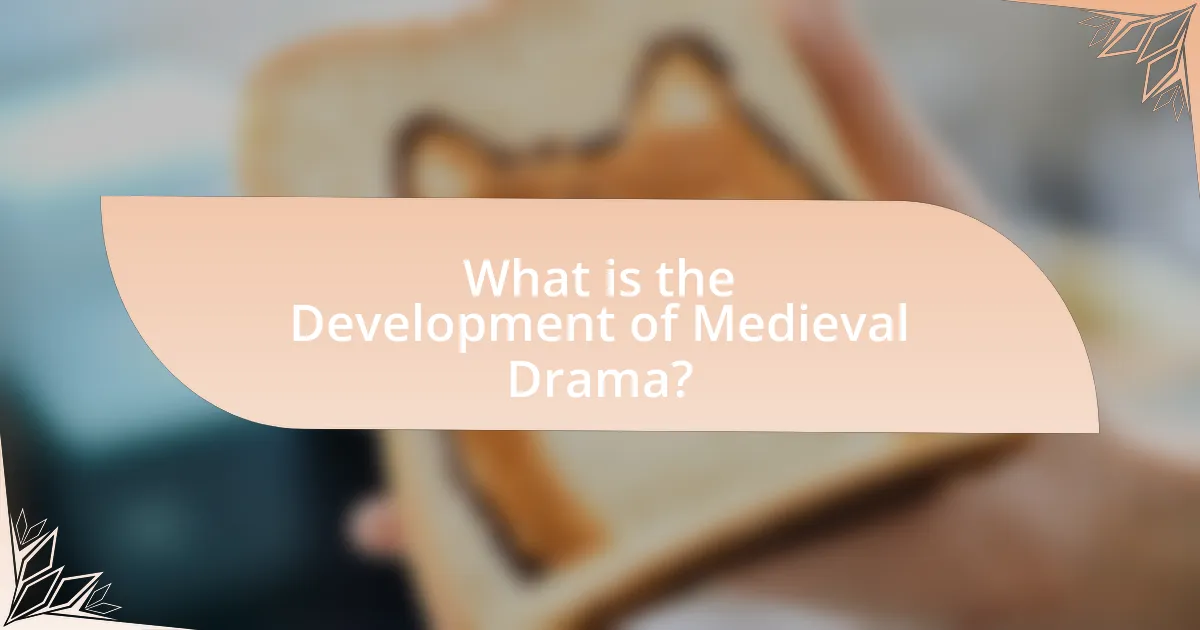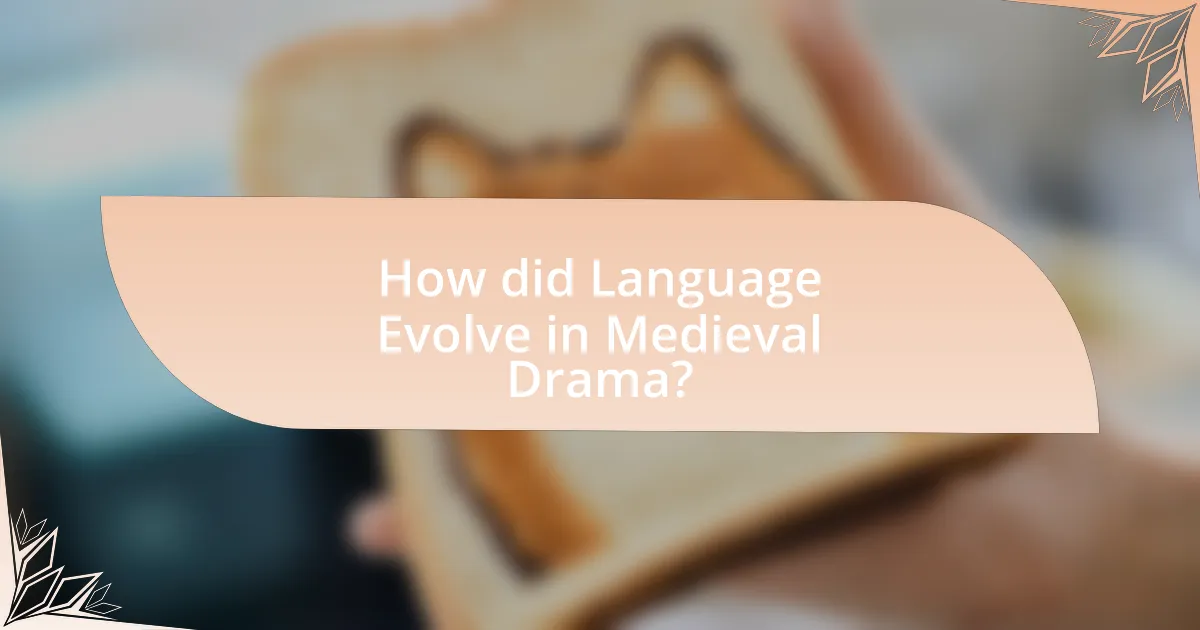The article focuses on the development of medieval drama and its language, tracing its origins from the 10th century with religious liturgical plays to the emergence of secular themes by the late medieval period. It highlights the transition from Latin to vernacular languages, which broadened audience engagement and facilitated the creation of morality and mystery plays. Key figures such as Hrosvitha of Gandersheim are discussed, along with the societal influences that shaped the themes and characteristics of medieval drama. The article also examines the impact of medieval drama on later theatrical traditions, particularly during the Renaissance, emphasizing the lasting significance of its narrative structures and linguistic evolution.

What is the Development of Medieval Drama?
The development of medieval drama began in the 10th century with the incorporation of religious themes into performances, primarily through liturgical plays. These early dramas evolved from church rituals and were performed in Latin, focusing on biblical stories to educate the largely illiterate population. By the 12th century, the introduction of vernacular languages allowed for broader audience engagement, leading to the creation of morality plays and mystery cycles that depicted moral lessons and the lives of saints. The transition from religious to secular themes occurred in the late medieval period, culminating in the emergence of farces and comedies that reflected contemporary societal issues. This evolution marked a significant shift in theatrical expression, paving the way for the Renaissance drama that followed.
How did Medieval Drama originate?
Medieval Drama originated from religious ceremonies and liturgical practices in the early Middle Ages. Initially, these performances were part of church services, where biblical stories were dramatized to educate the largely illiterate population. The transition from these religious roots to more secular themes occurred around the 12th century, leading to the development of mystery plays, morality plays, and eventually, interludes. Historical records indicate that the first known performance of a mystery play took place in 1210 in England, showcasing the evolution of drama as a form of public entertainment.
What historical events influenced the rise of Medieval Drama?
The rise of Medieval Drama was significantly influenced by the Christian Church’s need for religious instruction and the societal changes following the fall of the Roman Empire. The Church began to incorporate theatrical elements into liturgical services around the 10th century, leading to the creation of tropes and mystery plays that depicted biblical stories. Additionally, the growth of towns and the emergence of a merchant class during the 12th century provided new audiences and venues for performances, further promoting the development of drama. The establishment of universities also contributed to the rise of secular themes in drama, as educated individuals sought to explore human experiences beyond religious narratives.
Who were the key figures in the early development of Medieval Drama?
The key figures in the early development of Medieval Drama include Hrosvitha of Gandersheim, a 10th-century nun who is recognized as the first known female playwright, and the anonymous authors of the mystery and morality plays that emerged in the 12th and 13th centuries. Hrosvitha’s works, such as “Dulcitius,” demonstrate the use of classical themes in a Christian context, influencing the direction of Medieval Drama. Additionally, the mystery plays, which depicted biblical stories, and morality plays, which illustrated moral lessons, were pivotal in shaping the theatrical landscape of the Middle Ages, reflecting the religious and social values of the time.
What are the main characteristics of Medieval Drama?
Medieval Drama is characterized by its religious themes, use of allegory, and incorporation of vernacular language. The primary focus of Medieval Drama was to convey moral lessons and biblical stories, often performed in churches or public spaces to educate the largely illiterate population. Additionally, the use of allegorical characters allowed for complex moral and ethical discussions, exemplified in plays like “Everyman.” The transition from Latin to vernacular languages in the 12th century made these performances more accessible, reflecting the cultural shift towards local languages and enhancing audience engagement. This evolution in language and content marked a significant development in the theatrical tradition of the Middle Ages.
How did the themes of Medieval Drama reflect societal values?
The themes of Medieval Drama reflected societal values by emphasizing morality, religious beliefs, and communal identity. These dramas often depicted biblical stories and moral lessons, reinforcing the importance of faith and ethical behavior in a society heavily influenced by the Church. For instance, morality plays like “Everyman” illustrated the consequences of one’s actions and the need for repentance, mirroring the societal emphasis on salvation and moral integrity. Additionally, the use of allegory in these plays allowed audiences to engage with complex social issues, such as sin and redemption, thereby reflecting the collective values and concerns of the medieval community.
What types of performances were common in Medieval Drama?
Common types of performances in Medieval Drama included mystery plays, morality plays, and miracle plays. Mystery plays depicted biblical stories and were often performed during religious festivals, showcasing events from the Creation to the Last Judgment. Morality plays focused on moral lessons, using allegorical characters to represent virtues and vices, aiming to instruct audiences on ethical behavior. Miracle plays dramatized the lives of saints and their miraculous deeds, emphasizing faith and devotion. These performance types were integral to the development of Medieval Drama, reflecting the religious and social values of the time.

How did Language Evolve in Medieval Drama?
Language in medieval drama evolved significantly from Latin to vernacular languages, reflecting broader societal changes. Initially, religious plays were performed in Latin, which limited accessibility to educated elites. However, as the audience expanded, playwrights began incorporating vernacular languages, such as Middle English and Old French, to engage a wider audience. This shift was evident in the emergence of morality plays and mystery cycles, which utilized everyday language and local dialects, making the content relatable and understandable. The transition also included the use of rhyme and meter, enhancing the rhythmic quality of performances. By the late medieval period, the language of drama had become a crucial tool for storytelling, allowing for greater emotional expression and character development, as seen in works by playwrights like Geoffrey Chaucer and the authors of the Wakefield Mystery Plays.
What languages were primarily used in Medieval Drama?
The primary languages used in Medieval Drama were Latin, Middle English, and various vernacular languages. Latin was predominantly used in religious plays and liturgical dramas, reflecting the influence of the Church during the medieval period. Middle English emerged as a significant language for secular and moral plays, particularly in England, as it became more accessible to the general populace. Additionally, regional vernacular languages were utilized in different parts of Europe, allowing local audiences to engage with the performances. This linguistic diversity in Medieval Drama illustrates the cultural and social dynamics of the time, as it transitioned from ecclesiastical to more secular themes.
How did Latin influence the language of Medieval Drama?
Latin significantly influenced the language of Medieval Drama by serving as the primary liturgical and scholarly language of the time. This influence is evident in the incorporation of Latin vocabulary, phrases, and structures into the vernacular languages used in drama, which helped shape the linguistic style and thematic content of plays. For instance, many early medieval plays were adaptations of Latin liturgical texts, such as tropes and sequences, which were transformed into dramatic performances. Additionally, the use of Latin in educational institutions and the Church ensured that playwrights and audiences were familiar with Latin terminology, further embedding it into the fabric of medieval theatrical language. This blending of Latin with local dialects contributed to the evolution of the vernacular drama that characterized the period.
What role did vernacular languages play in the development of Medieval Drama?
Vernacular languages were crucial in the development of Medieval Drama as they made theatrical performances accessible to a broader audience. By using local languages instead of Latin, which was primarily understood by the educated elite, playwrights and performers could engage the general populace, fostering a more inclusive cultural experience. This shift is evidenced by the emergence of plays in English, French, and other vernaculars during the 12th to 15th centuries, such as the mystery plays and morality plays, which reflected the everyday lives and concerns of common people. The adoption of vernacular languages not only democratized theater but also contributed to the evolution of national identities and literary traditions, as seen in the works of playwrights like William Langland and the Wakefield Master.
How did the language of Medieval Drama change over time?
The language of Medieval Drama evolved significantly from the early to late Middle Ages, transitioning from Latin to vernacular languages. Initially, most medieval plays were performed in Latin, which limited accessibility to educated audiences. By the 12th century, as the use of vernacular languages like Middle English, Old French, and German increased, playwrights began incorporating these languages into their works, making drama more relatable to the general populace. This shift was influenced by the rise of the merchant class and the growing importance of local culture, as seen in the emergence of morality plays and mystery cycles that reflected contemporary social issues. The gradual adoption of vernacular languages culminated in the 15th century, where playwrights like William Shakespeare further popularized English, marking a significant departure from the earlier reliance on Latin.
What linguistic features were prominent in Medieval Drama texts?
Medieval Drama texts prominently featured the use of vernacular language, rhyme, and alliteration. The shift from Latin to vernacular languages allowed for broader audience engagement, as plays were performed in the native tongues of the people, such as Middle English, which made the content more accessible. Rhyme was often employed to enhance memorability and musicality, while alliteration contributed to the rhythmic quality of the dialogue, reflecting the oral traditions of storytelling. These linguistic features were essential in shaping the dramatic form and making the performances resonate with contemporary audiences.
How did the audience’s understanding of language affect performances?
The audience’s understanding of language significantly influenced performances by determining their engagement and comprehension of the narrative. When audiences possessed a strong grasp of the vernacular used in medieval drama, they were more likely to connect with the themes and characters, enhancing their overall experience. Conversely, if the audience struggled with the language, it could lead to confusion and disengagement, ultimately diminishing the impact of the performance. Historical evidence shows that plays were often adapted to reflect the local dialects and linguistic nuances of the audience, ensuring that the language resonated with them and facilitated a deeper emotional response. This adaptability in language use underscores the critical role that audience comprehension played in the effectiveness of medieval performances.

What Impact Did Medieval Drama Have on Later Theatre?
Medieval drama significantly influenced later theatre by establishing foundational elements such as structured narratives, character development, and the use of dialogue. The transition from religious morality plays to secular themes in the late medieval period paved the way for the Renaissance’s exploration of human experience and emotion in drama. Additionally, the incorporation of vernacular language in medieval plays made theatre more accessible to the general populace, setting a precedent for future playwrights to engage with broader audiences. This evolution is evidenced by the works of playwrights like Shakespeare, who drew upon the narrative techniques and character complexities that emerged during the medieval period, thereby shaping the trajectory of Western theatre.
How did Medieval Drama influence the Renaissance theatre?
Medieval drama significantly influenced Renaissance theatre by introducing structured narratives, character development, and the use of vernacular language. The transition from religious morality plays and mystery cycles in the medieval period laid the groundwork for the more complex storytelling and character-driven plots seen in Renaissance works. Additionally, the incorporation of local dialects and everyday language in medieval performances made theatre more accessible to the general populace, a trend that continued into the Renaissance, allowing playwrights like Shakespeare to connect with broader audiences. This evolution in language and narrative style marked a pivotal shift from the didactic nature of medieval drama to the more humanistic and secular themes prevalent in Renaissance theatre.
What elements of Medieval Drama can be seen in Renaissance plays?
Renaissance plays exhibit several elements of Medieval Drama, including the use of morality themes, allegorical characters, and religious motifs. Morality plays, which were prevalent in the medieval period, often conveyed moral lessons through characters representing virtues and vices; this approach influenced Renaissance playwrights like Christopher Marlowe and William Shakespeare, who incorporated similar themes into their works. Additionally, the use of allegorical characters, such as those found in the medieval “Everyman,” can be seen in Renaissance plays where characters often symbolize broader human experiences or societal issues. Furthermore, the incorporation of religious motifs, which were central to Medieval Drama, persisted in Renaissance plays, reflecting the ongoing influence of religious narratives and moral questions in the evolving theatrical landscape.
How did the transition from Medieval to Renaissance drama reflect changes in language?
The transition from Medieval to Renaissance drama reflected significant changes in language through the shift from Latin and French to vernacular languages. During the Medieval period, drama primarily utilized Latin and French, limiting accessibility to educated elites. However, the Renaissance saw a rise in the use of vernacular languages, such as English, which allowed broader audiences to engage with theatrical works. This linguistic shift is exemplified by playwrights like William Shakespeare, who incorporated everyday speech and regional dialects into his plays, enhancing relatability and emotional depth. The increased emphasis on individual expression and human experience during the Renaissance further influenced the evolution of language in drama, leading to more complex characters and themes.
What lessons can be learned from the development of Medieval Drama?
The development of Medieval Drama teaches the importance of using performance as a means of communicating complex social and religious themes. This theatrical form emerged in the 10th century, evolving from liturgical plays to more secular narratives, reflecting societal changes and the growing influence of vernacular languages. The use of allegory and morality plays illustrates how drama can convey moral lessons and engage audiences in critical reflection on ethical issues. Additionally, the collaboration between clergy and laypeople in producing these dramas highlights the role of community in cultural expression and the democratization of storytelling.
How can modern playwrights draw inspiration from Medieval Drama?
Modern playwrights can draw inspiration from Medieval Drama by incorporating its themes of morality, community, and the use of allegory. Medieval Drama often focused on moral lessons and the human condition, which can resonate with contemporary audiences seeking depth in storytelling. Additionally, the communal aspect of Medieval performances, often staged in public spaces, can inspire modern playwrights to create works that engage with their communities and address social issues. The use of allegorical characters in Medieval plays, representing virtues and vices, can also inform character development in modern narratives, allowing for a rich exploration of human behavior. These elements highlight the enduring relevance of Medieval Drama in shaping modern theatrical practices.
What best practices can be applied from the language of Medieval Drama in contemporary theatre?
Best practices from the language of Medieval Drama that can be applied in contemporary theatre include the use of heightened language, allegorical themes, and communal storytelling. Heightened language, characterized by its poetic structure and rhythmic patterns, can enhance emotional resonance and engage audiences more deeply, as seen in works like “Everyman,” which employs verse to convey moral lessons. Allegorical themes, prevalent in Medieval plays, allow for exploration of complex social and ethical issues, providing a framework for contemporary narratives that address modern dilemmas. Additionally, the communal storytelling aspect of Medieval Drama, where audiences participated in the performance, can be adapted to create immersive experiences in contemporary theatre, fostering a sense of connection and shared experience among viewers. These practices not only enrich the theatrical experience but also draw on historical techniques that have proven effective in engaging audiences.